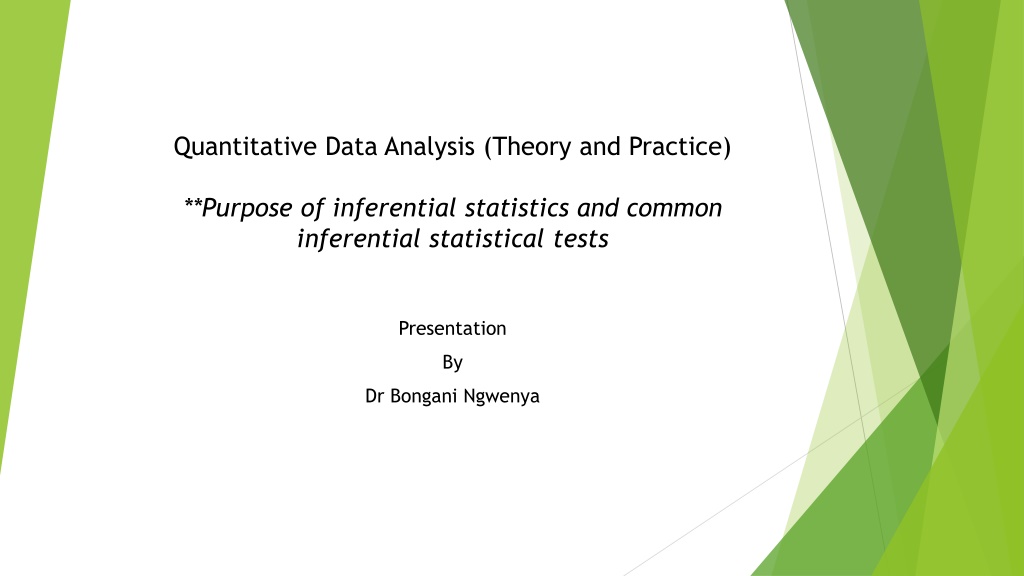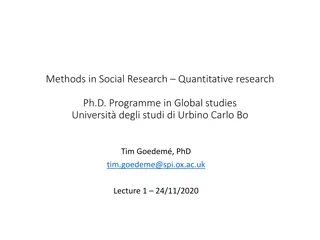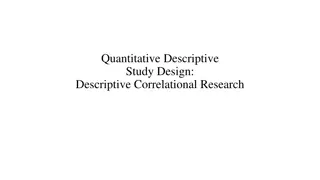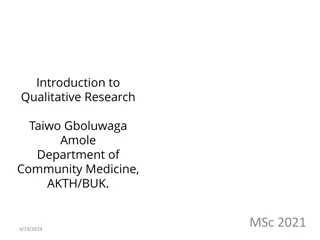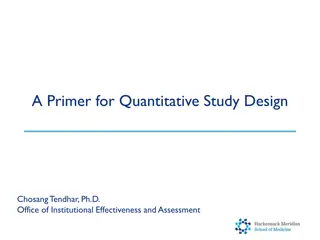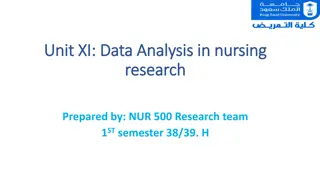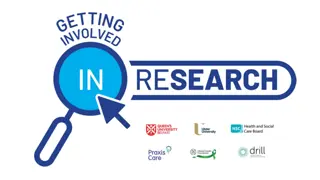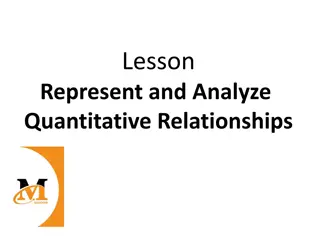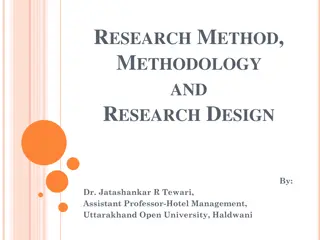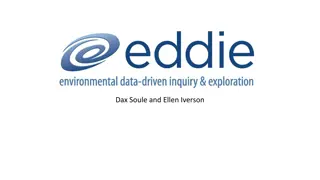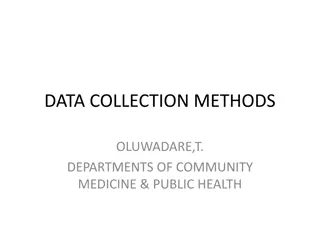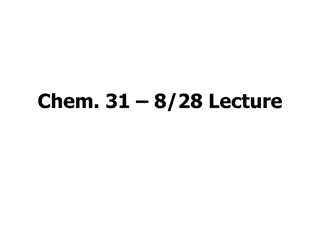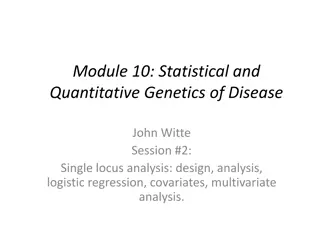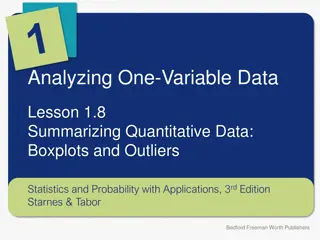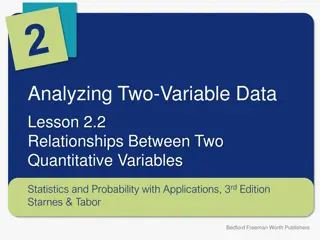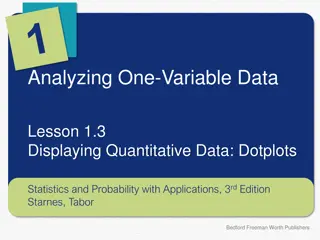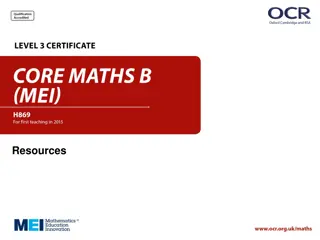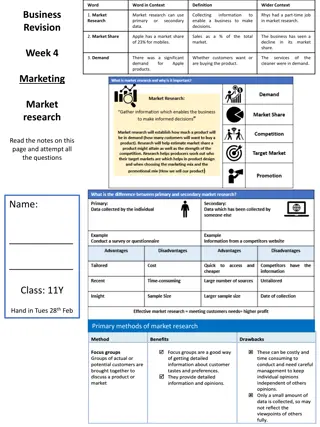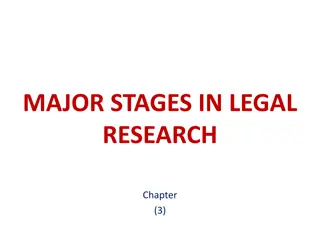Understanding Quantitative Data Analysis in Research
In quantitative data analysis for research, the type of research question influences the statistical methods used. Descriptive questions describe a situation without hypothesis testing. Comparative questions compare variables to assess differences, using tests like t-test and ANOVA. Relational questions explore relationships between variables using correlation and regression analyses.
Download Presentation

Please find below an Image/Link to download the presentation.
The content on the website is provided AS IS for your information and personal use only. It may not be sold, licensed, or shared on other websites without obtaining consent from the author. Download presentation by click this link. If you encounter any issues during the download, it is possible that the publisher has removed the file from their server.
E N D
Presentation Transcript
Quantitative Data Analysis (Theory and Practice) **Purpose of inferential statistics and common inferential statistical tests Presentation By Dr Bongani Ngwenya
Quantitative Data Analysis To analyse quantitative data we use statistics Research question(s) and data types dictate analysis and statistical methods Your research questions are the heart of your dissertation or thesis they come from your problem and purpose statement and guide your data collection and analysis. How you word your research questions influences the depth and breadth of inferences (using inferential statistics) you can make in your results and discussion. There are three types of quantitative research questions you can ask: descriptive, comparative/difference, and relational/association. First, there are descriptive research questions. These types of questions seek to simply describe a situation, or problem and do not include any hypothesis testing, i.e. descriptive statistics does not test the hypothesis as it is not inferential.
Quantitative Data Analysis Imagine that your Doctoral study is interested in the leadership style of ice cream shop employers and the job satisfaction of their employees. Descriptive research questions for this area of study could be: What is the leadership style of ice cream shop employers? What is the job satisfaction of ice cream shop employees? For these questions, means and standard deviations or frequencies and percentages would be calculated, depending on the level of measurement of the variables. Or, you could create a comparative research question. These are used to compare variables or groups in order to assess differences between them. A question of this type could be: Is there a significant difference in the job satisfaction of ice cream shop employees who have ice cream shop employers with different leadership styles? Comparative analyses that seek to assess differences include the t-test and the analysis of variance (ANOVA) family of tests.
Quantitative Data Analysis Finally, there are relational or associational research questions. These types of questions seek to assess the relationship or the association between two or more variables or groups. These types of questions could be phrased as: Does the leadership style of ice cream shop employers predict job satisfaction of ice cream shop employees? Is there an association or correlation between leadership style of ice cream shop employers and job satisfaction of ice cream shop employees? Notice that here, there are two different relational questions. One uses the word predict and the other uses the word correlation or association. There are several buzzwords in quantitative research that indicate very specific analyses, including predict, correlation, difference, relationship, positive, negative, and etc.
Quantitative Data Analysis The use of the word predict indicates the use of a regression analysis. The use of the word correlate indicates the use of a simple correlation analysis. N.B. If we use the word difference , we have created a comparative research question. If you use the word relationship , you have created a relational research question that is more general than using the words predict or correlate, leaving you with more options when it comes down to cementing your data analysis. The terms positive and negative are augmenting words that can be added to your research question if you want to be specific with the hypothesised direction of the relationship between variables. These should only be used when there is significant evidence in the literature to support your research question and associated hypotheses, as using these terms limits your ability to reject your null hypothesis.
Quantitative Data Analysis For example, if you had asked: Is there a significant positive correlation between age and the job satisfaction of ice cream shop employees? Your null hypothesis would be: There is no significant positive correlation between age and the job satisfaction of ice cream shop employees. Suppose you ran your results and actually found that there is a significant negative correlation between the two variables. You found a significant result, but you still could not reject your null hypothesis, as you did not find a positive correlation. N.B Use these only when you want to make a specific directional hypothesis and there is substantial evidence in the literature to guide your hypothesis. How you word your research question affects whether you can make any sort of inference for example, if you only ask a descriptive question, you cannot assess whether your independent variable predicts your dependent variable, or if there are any differences between groups. Your entire dissertation or thesis should be carefully planned and orchestrated, even down to the specific wording of your research questions!
Everything you need to complete your quantitative data analysis If you are analysing quantitative data as part of your dissertation, thesis or research project it is my hope that the following comprehensive, step-by-step guide will help you. (1) select the correct inferential statistical tests to analyse your data with. (2) carry out those statistical test using IBM SPSS Statistics. (3) understand and write up your results.
Select the commonly used correct inferential statistical tests to analyse your data with The theories behind selection of correct inferential statistical tests to analyse data (1) THEORY OF DIFFERENCES BETWEEN GROUPS Independent-samples t-test Paired-samples t-test One-way ANOVA One sample One-sample t-test Chi-square goodness-of-fit (2) THEORY OF PREDICTING SCORES Linear regression Multiple regression
Select the commonly used correct inferential statistical tests to analyse your data with, continued (3) THEORY OF ASSOCIATIONS Pearson's correlation Spearman's correlation Chi-square test for association (2x2) Chi-square test of independence (RxC) Fisher's exact test (2x2) for independence
Two independent samples t-test An independent samples t-test is used when we want to compare the means of a normally distributed interval dependent variable for two independent groups. For example, say we wish to test whether the mean for write is the same for males and females. Because the standard deviations for the two groups are similar (10.3 and 8.1), we will use the equal variances assumed test. The results indicate that there is a statistically significant difference between the mean writing score for males and females (t = -3.734, p = .000). In other words, females have a statistically significantly higher mean score on writing (54.99) than males (50.12).
One sample t-test A one-sample t-test allows us to test whether a sample mean (of a normally distributed interval variable) significantly differs from a hypothesized value. For example, using the hsb2 data file, say we wish to test whether the average writing score (write) differs significantly from 50. We can do this as shown below. The mean of the variable write for this particular sample of students is 52.775, which is statistically significantly different from the test value of 50. We would conclude that this group of students has a significantly higher mean on the writing test than 50.
Paired t-test A paired (samples) t-test is used when we have two related observations (i.e., two observations per subject) and we want to see if the means on these two normally distributed interval variables differ from one another. For example, we will test whether the mean of read is equal to the mean of write. These results indicate that the mean of read is not statistically significantly different from the mean of write (t = -0.867, p = 0.387).
Chi-square test A chi-square test is used when we want to see if there is a relationship between two categorical variables. Let s look at an example, i.e. if there is a linear relationship between gender (female) and socio-economic status (ses). The point of this example is that one (or both) variables may have more than two levels, and that the variables do not have to have the same number of levels. In this example, female has two levels (male and female) and ses has three levels (low, medium and high). We find that there is no statistically significant relationship between the variables (chi-square with two degrees of freedom = 4.577, p = 0.101).
One-way ANOVA A one-way analysis of variance (ANOVA) is used when we have a categorical independent variable (with two or more categories) and a normally distributed interval dependent variable and we wish to test for differences in the means of the dependent variable broken down by the levels of the independent variable. For example, say we wish to test whether the mean of write differs between the three program types (prog). The mean of the dependent variable differs significantly among the levels of program type. From this we can see that the students in the academic program have the highest mean writing score, while students in the vocational program have the lowest.
Linear Regression Analysis Possible linear research questions: Does income predict price? What is the impact of income on price? To what extent is price predicted by income? SPSS Statistics will generate quite a few tables of output for a linear regression analysis. In this section, we show only the three main tables required to understand your results from the linear regression procedure. The first table of interest is the Model Summary table, as shown below:
Linear Regression Analysis The model summary table provides the R and R2values. The R value represents the simple correlation and is 0.873 (the "R" Column), which indicates a high degree of correlation. The R2value (the "R Square" column) indicates how much of the total variation in the dependent variable, Price, can be explained by the independent variable, Income. In this case, 76.2% of the price can be explained by income, which is very large. The next table is the ANOVA table, which reports how well the regression equation fits the data (i.e., predicts the dependent variable) and is shown below:
Linear Regression Analysis The ANOVA table indicates that the regression model predicts the dependent variable significantly well. How do we know this? Look at the "Regression" row and go to the "Sig." column. This indicates the statistical significance of the regression model that was run. Here, p < 0.000, which is less than 0.05, and indicates that, overall, the regression model statistically significantly predicts the outcome variable (i.e., it is a good fit for the data).
Linear Regression Analysis The Coefficients table provides us with the necessary information to predict price from income, as well as determine whether income contributes statistically significantly to the model (by looking at the "Sig." column). Furthermore, we can use the values in the "B" column under the "Unstandardized Coefficients" column, as shown below to present the regression equation as: Price = 8287 + 0.564(Income)
Multiple Regression Analysis Potential multiple regression research questions: Do gender, age, heart-rate and weight predict maximum oxygen uptake? To what extent does gender, age, heart-rate and weight predict or explain maximum oxygen uptake? SPSS Statistics will generate quite a few tables of output for a multiple regression analysis. In this section, we show only the three main tables required to understand your results from the multiple regression procedure. We focus only on the three main tables you need to understand your multiple regression results. The first table of interest is the Model Summary table. The model summary table provides the R, R2, adjusted R2, and the standard error of the estimate, which can be used to determine how well a regression model fits the data.
Multiple Regression Analysis The "R" column represents the value of R, the multiple correlation coefficient. R can be considered to be one measure of the quality of the prediction of the dependent variable; in this case, VO2max(Maximum Oxygen Uptake). A value of 0.760, in this example, indicates a good level of prediction. The "R Square" column represents the R2value (also called the coefficient of determination), which is the proportion of variance in the dependent variable that can be explained by the independent variables (technically, it is the proportion of variation accounted for by the regression model above and beyond the mean model). You can see from our value of 0.577 that our independent variables explain 57.7% of the variability of our dependent variable, VO2max.
Multiple Regression Analysis The F-ratio in the ANOVA table (see below) tests whether the overall regression model is a good fit for the data. The table shows that the independent variables statistically significantly predict the dependent variable, F(4, 95) = 32.393, p < .0005 (i.e., the regression model is a good fit of the data).
Multiple Regression Analysis Estimated model coefficients The general form of the equation to predict VO2max from age, weight, heartrate, gender, is: predicted VO2max = 87.83 (0.165 x age) (0.385 x weight) (0.118 x heartrate) + (13.208 x gender) Unstandardized coefficients indicate how much the dependent variable varies with an independent variable when all other independent variables are held constant. Consider the effect of age in this example. The unstandardized coefficient, B1, for age is equal to -0.165 (see Coefficients table). This means that for each one year increase in age, there is a decrease in VO2max of 0.165 ml/min/kg.
Multiple Regression Analysis Statistical significance of the independent variables You can test for the statistical significance of each of the independent variables. This tests whether the unstandardized (or standardized) coefficients are equal to 0 (zero) in the population. If p < .05, you can conclude that the coefficients are statistically significantly different to 0 (zero). The t-value and corresponding p-value are located in the "t" and "Sig." columns, respectively, as highlighted below:
Multiple Regression Analysis You can see from the "Sig." column that all independent variable coefficients are statistically significantly different from 0 (zero). Although the intercept, B0, is tested for statistical significance, this is rarely an important or interesting finding.
Multiple Regression Analysis Putting it all together You could write up the results as follows: A multiple regression was run to predict VO2max from gender, age, weight and heart rate. These variables statistically significantly predicted VO2max, F(4, 95) = 32.393, p < .000, R2= .577. All four variables added statistically significantly to the prediction, p < .05.
Correlation Analysis Example: A researcher wants to know whether a person's height is related to how well they perform in a long jump. The researcher recruited untrained individuals from the general population, measured their height and had them perform a long jump. The researcher then investigated whether there was an association between height and long jump performance by running a Pearson's correlation. Potential correlation research questions: Is there a correlation between height and long jump performance? Is there an association between height and long jump performance? SPSS Statistics generates a single Correlations table that contains the results of the Pearson s correlation procedure that you ran in the previous section.
Correlation Analysis Here we focus on the results from the Pearson s correlation procedure only, assuming that your data met all the relevant assumptions. Therefore, when running the Pearson s correlation procedure, you will be presented with the Correlations table in the IBM SPSS Statistics Output Viewer. The Pearson's correlation result is highlighted below:
Correlation Analysis The results are presented in a matrix such that, as can be seen above, the correlations are replicated. Nevertheless, the table presents the Pearson correlation coefficient, its significance value and the sample size that the calculation is based on. In this example, we can see that the Pearson correlation coefficient, r, is 0.706, and that it is statistically significant (p = 0.005). Reporting the Output In our example above, you might report the results as follows: A Pearson correlation was run to determine the relationship between height and distance jumped in a long jump. There was a strong, positive correlation between height and distance jumped, which was statistically significant (r = .706, n = 14, p = .005).
Correlation Analysis Example A teacher is interested in whether those who do better at English also do better in maths, i.e. there is monotonic relationship between the two variables. Potential research question: Do students that perform better in English also perform better in Maths? To test whether this is the case, the teacher records the scores of her 10 students in their end-of-year examinations for both English and maths. Therefore, one variable records the English scores and the second variable records the maths scores for the 10 pupils. In SPSS Statistics, we created two variables so that we could enter our data: English_Mark (i.e., English scores) and Maths_Mark (i.e., maths scores).
Correlation Analysis We focus on the results from the Spearman s correlation procedure only. Therefore, after running the Spearman s correlation procedure, we are presented with the Correlations table, as shown below:
Correlation Analysis The results are presented in a matrix such that, as can be seen above, the correlations are replicated. Nevertheless, the table presents Spearman's correlation, its significance value and the sample size that the calculation was based on. In this example, we can see that Spearman's correlation coefficient, rs, is 0.669, and that this is statistically significant (p = .035). Reporting the Output: In our example, you might present the results as follows: A Spearman's correlation was run to determine the relationship between 10 students' English and maths exam marks. There was a strong, positive correlation between English and maths marks, which was statistically significant (rs(8) = .669, p = .035). Meaning, those students who do well in English also do well in Mathematics.
